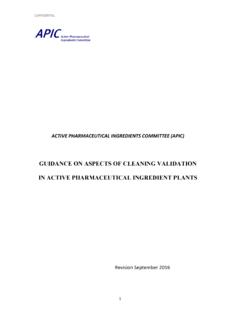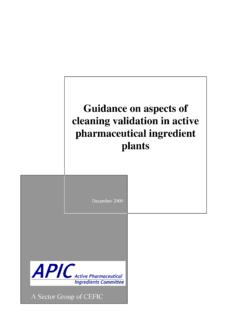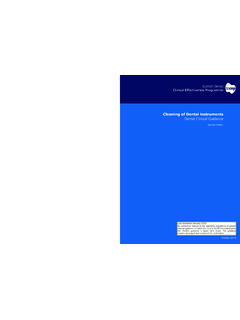Transcription of Validation of Production Processes for Vaccines for …
1 Validation of Production Processes for Vaccines for WHO Prequalification- compliance expectations A note for guidance for the manufacture of prequalified Vaccines for supply to United Nations agencies July, 2013 Vaccine Quality and Regulations (VQR) Essential Medicines and Health Products World Health Organization (WHO), Geneva, Switzerland Page 2 of 37 This guidance document Validation of Production Processes for Vaccines for WHO Prequalification - compliance expectations is one of a series developed by WHO/EMP/VQR team upon request from the manufacturers members of the Developing Countries Vaccine Manufacturers Network (DCVMN), with funds from USAID.
2 A set of priority topics has been identified by vaccine manufacturers for WHO to provide guidance on the expectations from the vaccine prequalification programme. The guidance document is targeted primarily at manufacturers new to the prequalification process of Vaccines and who require guidance on the level of detail needed for process Validation activities. It may also be a useful guide to National Regulatory Authorities (NRAs) in vaccine producing countries for the purpose of regulatory inspection. These are not official WHO documents but rather notes for guidance on expected standards to be met for the prequalification of Vaccines .
3 Based on WHO recommended requirements, these documents provide further explanations with examples in order to facilitate implementation. Page 3 of 37 Table of Contents Page 1. Introduction 4 2. Purpose 4 3. Scope 5 4. Lifecycle Approach in Process Validation : from R&D through clinical trials to commercial scale 5 Validation risk assessment What needs to be validated and when 7 5. Process Validation Stages 8 Validation Stage I 8 Validation Stage II 18 Validation Stage III 29 Revalidation 30 Validation Studies and the WHO Pre-Qualification process expectations 31 Appendix 1 33 Glossary 34 References 35 Acknowledgements 37 Page 4 of 37 1.
4 Introduction Companies should validate their manufacturing Processes by acquiring sufficient knowledge about the characteristics of the product to be manufactured, and by having an appropriate Production process control prior to the manufacturing of the first commercial batch. This approach assures consistency of the Production process and demonstrates the capability of the commercial manufacturing process to give a high degree of assurance of obtaining medicinal products meeting the required quality attributes of safety, purity, and efficacy on a continued basis.
5 Process Validation (PV) is the collection and evaluation of data, from the process design stage through commercial Production , which establishes scientific evidence that a manufacturing process is capable of consistently delivering quality products. Process Validation is required by current Good Manufacturing Practice (cGMP) as an essential element in the assurance of drug quality (22). Process Validation is also typically defined as documented evidence which provides a high degree of assurance that a specific process will consistently result in a product that meets its predetermined specifications and quality attributes (1).
6 Product quality requires full compliance with WHO GMP requirements, including a meaningful process Validation program based on the assumption that quality cannot be adequately assured merely by in-process and finished-product inspection and testing (2) Validation offers assurance that a process is reasonably protected against sources of variability that could affect Production output, cause supply problems, and negatively affect public health .(2) PV also proves that in spite of changes in operational parameters through the necessary scale up of the Production process, including new facilities and equipment, the product characteristics will not vary.
7 This guidance document considers process Validation as part of the product s life cycle as recommended by the International Conference on Harmonization (ICH) in Q8 Pharmaceutical Development and Q10 Pharmaceutical Quality System, and is in line with the requirements of both FDA and EU. 2. Purpose This guidance document is aimed at presenting current WHO main expectations towards process Validation , and at supporting effective and timely implementation of Validation programs as they relate to vaccine manufacturing. It is intended to assist manufacturers in assuring reliable, reproducible and robust manufacturing Processes before the first commercial batch is produced, and insure that process changes will result in a product with equal or superior quality characteristics.
8 This document is based on WHO GMP regulations, as well as other internationally recognized GMP regulations, guidelines and publications, in addition to incorporating the experience of experts and auditors in the field. This note for guidance also provides manufacturers with non-binding information concerning the criteria currently used by WHO for the assessment of prequalified human Vaccines . Page 5 of 37 3. Scope This guidance provides an updated general view of relevant points to consider related to process Validation of vaccine and biopharmaceutical Production Processes , which apply to all manufacturing stages from seed or cell culture to final drug product.
9 This guidance primarily applies to new products although legacy products may also benefit from adopting such an approach. The following are some manufacturing Processes requiring Validation which are covered in this document: Fermentation Harvesting Purification Viral Clearance Inactivation Blending & Formulation Lyophilization Other critical manufacturing Processes are briefly described, considering there is extensive guidance on them, including: Cleaning of product contact equipment Sanitization of areas Depyrogenation Sterilization Aseptic Filling or encapsulation process of Final Product Utilities, facility and equipment qualification, analytical assay Validation , and Validation of computerized systems are referenced but not covered in this document.
10 4. Lifecycle Approach in Process Validation : from R&D through clinical trials to commercial scale Lifecycle approach is the recommended approach to achieve quality in pharmaceutical products as it is oriented to facilitating innovation and continual improvement, as well as to strengthen the link between pharmaceutical development and manufacturing (8). A central concept in this approach is that process Validation should not be viewed as a one-time event but rather as an activity that spans the product lifecycle linking process development, Validation of commercial manufacturing process, and its maintenance during routine commercial Production (22).















